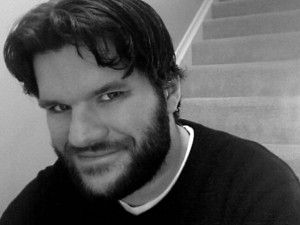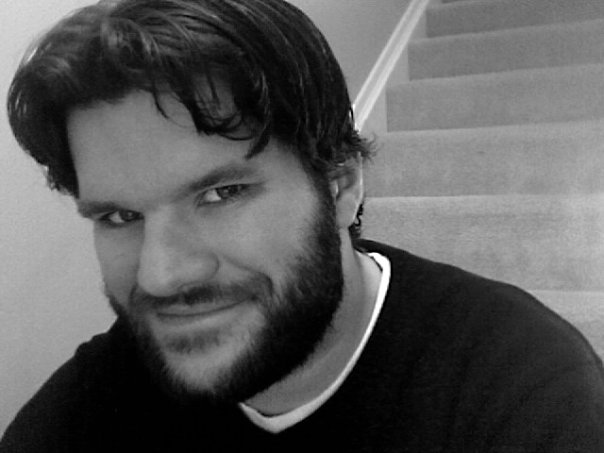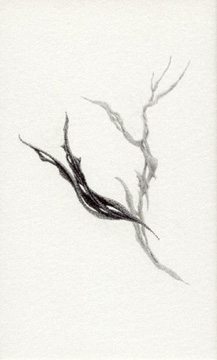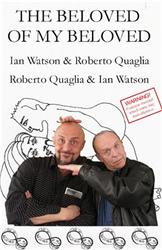 Matt Bell is the author of How They Were Found, a collection of fiction published by Keyhole Press in 2010, and Cataclysm Baby, a novella forthcoming from Mud Luscious Press in 2012, as well as three chapbooks, Wolf Parts, The Collectors, and How the Broken Lead the Blind. His fiction has appeared in Conjunctions, Hayden’s Ferry Review, Gulf Coast, Willow Springs, Unsaid, and American Short Fiction, and has been selected for inclusion in anthologies such as Best American Mystery Stories 2010 and Best American Fantasy 2. His book reviews and critical essays have appeared in The Los Angeles Times, American Book Review, and The Quarterly Conversation.
Matt Bell is the author of How They Were Found, a collection of fiction published by Keyhole Press in 2010, and Cataclysm Baby, a novella forthcoming from Mud Luscious Press in 2012, as well as three chapbooks, Wolf Parts, The Collectors, and How the Broken Lead the Blind. His fiction has appeared in Conjunctions, Hayden’s Ferry Review, Gulf Coast, Willow Springs, Unsaid, and American Short Fiction, and has been selected for inclusion in anthologies such as Best American Mystery Stories 2010 and Best American Fantasy 2. His book reviews and critical essays have appeared in The Los Angeles Times, American Book Review, and The Quarterly Conversation.
He works as an editor at Dzanc Books, where he also runs the literary magazine The Collagist. He teaches writing at the University of Michigan.
MMR: How They Were Found is a collection of 13 stories, with a subtle, organic progression between one story and the next. Albeit tangentially, there is usually something that ties them together—a knife, a birth, an inventory of life. Yet each story also interplays with the title—How They Were Found—in vastly different ways. In the first story, “The Cartographer’s Girl,” the relation to the title is one of wry humor from an obsessive romantic; but as we progress, the characters are ‘found’ in increasingly more complicated situations. Did you have this intent, the dynamic nature between title and stories, in mind when selecting these pieces? Or did the title ‘make itself known’ only at the end?
MB: The title came out of the very end of the process: I’d written all of the stories before I ever tried to collect them or order them. It was a difficult book to title in some way, and it actually ended up coming from a title that was given to two parts of The Collectors, which were previously published at Wigleaf, under the title: “How They Were Found and Who They Were That Found Them.” That seemed to fit the obsessions of the book in a variety of different ways that I found pleasing; and that, as you pointed out, grew more complex as the book went on.
MMR: When reading these stories, I was amazed at how fluently and convincingly you transition between such varied voices. In particular, I was surprised by how accurately and movingly you conveyed women. In “His Last Great Gift” and “Her Ennead,” you capture a range of emotions that I thought were purely feminine—the hope and uncertainty, strength and weakness, of birth and labor; the altruistic submissiveness required for comforting another. Were you raised among many sisters? Was it your wife Jessica who taught you so well? How is it that you came to know the feminine mystique so intimately?
MB: I do have two younger sisters, and of course I’ve spent a lot of time with Jessica, but I wouldn’t necessarily say that these qualities come from anyone in specific. Mostly I never think of writing women characters any different than I do of writing men: I don’t think the differences between the genders are so extreme as to require a different approach. For instance, while “Her Ennead” is obviously centered around a woman’s fears of pregnancy, I wrote it out of my fear of the future, fear of loss—I don’t have to be a woman or a parent to know what it’s like to be afraid of a coming change, of losing what I’m sworn to protect, or of hurting the ones I’d love even though I’d do anything to keep from hurting them. It’s those kinds of emotions that I went to for those characters, and really, they’re part of me as a man as much as they are any conception of what I think it would be like to be a woman.
 MMR: “Dredge,” one that made my skin crawl and my heart ache, features a protagonist, Punter, who seems to be a combination of Norman Bates and the main character from Slingblade. The tension is severe, and the main character—despite all logic or events—is somehow still emotionally compelling and innocent. Then, in “Hold On to Your Vacuum,” you use metaphor to turn our all-too-human struggle inside out. The effect creates a disturbing dark comedy of self-reflection. In “Wolf Parts” and especially in “An Index Of How Our Family Was Killed,” you use a postmodern approach rather than conventional narrative. You’ve been published in over 70 literary magazines and included in best-of anthologies of mystery and fantasy. Do you love to experiment with form and style? Do you have a favorite, or does the story itself determine which form it will take?
MMR: “Dredge,” one that made my skin crawl and my heart ache, features a protagonist, Punter, who seems to be a combination of Norman Bates and the main character from Slingblade. The tension is severe, and the main character—despite all logic or events—is somehow still emotionally compelling and innocent. Then, in “Hold On to Your Vacuum,” you use metaphor to turn our all-too-human struggle inside out. The effect creates a disturbing dark comedy of self-reflection. In “Wolf Parts” and especially in “An Index Of How Our Family Was Killed,” you use a postmodern approach rather than conventional narrative. You’ve been published in over 70 literary magazines and included in best-of anthologies of mystery and fantasy. Do you love to experiment with form and style? Do you have a favorite, or does the story itself determine which form it will take?
MB: I grew up as a reader of mostly genre fiction, especially science fiction and fantasy, so elements of that definitely still pervade my fiction, which accounts for at least some of the range. For the most part, I rarely start with an idea for the structure of a story (with, perhaps, obvious excepts like “An Index of How Our Family Was Killed,” which was form first and content second. Mostly I start writing without any idea at all of what I’m going to be writing about, and then things take off once I find the voice: I mostly just try to expand a story one sentence at a time in the first draft, seeing where the voice is taking me. So for the most part, all these different forms and genres in the book came out of the voice I found, and what that voice had to say. It’s a fun way to write, because I get to experience the thing first as a new story being told, uncovered as it unfolds.
MMR: There are two stories, “The Receiving Tower” and “His Last Great Gift,” that were so provoking and complex that I’d like you to unpack them a bit more. In “The Receiving Tower” you paint a grey dystopia marked by forgetting; where soldiers can no longer distinguish between who leads and who follows, nor tell whether their memories are their own. Is this a commentary on life? The slow death of memory as the prerequisite for living? Or was this a reflection of war, of the endless sacrifices that ultimately remake a person in war’s image? Where the only escape or comfort is in death? Or what?
MB: One of the themes I didn’t realize I had running through my stories from this period until after I started to collect them is that my characters often take on roles to start the story: They become a detective, or a parent, or a cartographer, and that somehow their fulfillment or failure of this role is what makes the story go. In Maon’s case, his fading memories means that in his role as the protector of the men in the tower he has to constantly make decisions from an unstable understanding of the situation: It was interesting to see how he’d react at each stage of the story, based on what information was and was not available to him, while keeping his essential character—his goodness and concern for the men—fairly static. And I think out of that emerged some of the themes you’ve mentioned, which hopefully have enough ambiguity to them to make them morally useful to the reader.
MMR: “His Last Great Gift” is epic; it felt like a Steampunk nativity tale of the Electric Messiah. An Old-West world inhabited by the spirits of our forefathers, the Electricizers; a Priest tasked with building the New Motor—an engine that will run on the energy of this new Messiah. This world-building and the Priest’s human struggles are magnificent, but I was surprised by the character of Maud Trenton. She, this New Mary, was so inspired; so unexpectedly holy. With her you untangle the great difference between religious hubris and real spirituality, and through her thoughts and words we see a huge love for and reverence of the divine. Is this true? Can you speak to your motivations and inspiration for this story?
MB: “His Last Great Gift” is based loosely on the life of John Murray Spears, a nineteenth-century spiritualist minister and medium, who did build his New Motor in the years before the Civil War. I’ve taken an immense amount of liberties with the story—only his character (and those of the Founding Fathers) are based on real people, and even then only loosely—but I was very much drawn to his writings from that time. He was part of a movement characterized by a sort of spiritual American exceptionalism that I think dates back to the founding of the American colonies, and continues today: There’s a sense in his work that America is the shining city on the hill, and that we’re somehow meant to be an example or a guiding light for the rest of the world. He really did seem to believe that his work, including the New Motor, would kick off an age of enlightenment in America that would result in a better, more just society, and it’s that belief—and the bizarreness of the New Motor and the New Mary—that obsessed me. I first starting thinking about writing about him about a year before I did, and it took a long time to find the voice to make it go. And then I got lucky again with the emergence of Maud Trenton: She’s one of my favorite characters in the book too, and I didn’t know anything about her until she first showed up in Spears’s office, and then started to take charge of the scenes she was in. Definitely one of those incredibly lucky occurrences that comes from sitting in the chair and working carefully.
As far as my own beliefs: I was raised Catholic, was extremely devout for two decades or so, and am an atheist now. But when you believe in something so strongly, it never fully leaves you. I’m an ex-Catholic in a way that is perhaps most like being an expatriate: I may have moved away and renounced my citizenship, but I haven’t lost my old accent just yet.
MMR: “The Collectors,” is a chapbook-length story based on the real lives of the Collyer brothers who lived in Manhattan and died as a result of their hoarding and isolation in 1947. Since then, there have been several attempts to tell their lives—by playwrights, through film, even E. L. Doctorow’s speculative fiction. But what makes your rendition so unique, and has earned you such praise throughout the literary world, is your art. You tell this story of two hoarders in a way that actually mimics their living conditions—the details and tangents around and within them; you recreate an entire world within their home, which both shielded and then killed them. Your narrator is powerless to stop it, and powerless to look away. A tale of obsession told by the obsessed. What was it that made you want to recreate this tale? Was it the brothers themselves, their tortured lives? How long did it take you to find your way around their story? And did you edit or change anything in its telling from your original publication?
MB: I can honestly say I hadn’t seen any of the other takes on the Collyers before I published mine, although certainly I was aware of some of them while doing research. (But not E.L. Doctorow’s Homer and Langley—that came out six months or so after “The Collectors” appeared as a chapbook.) I first read about them the summer before, in a book I found while visiting my mother: It was actually a daily devotional kind of book she had lying around, and they were an example of what happens to people who don’t learn how to let go of things. But that little summary of their life intrigued me, and I started thinking about them quite a bit: It’s really a fantastic tragedy, and all the elements of a good story are sort of pre-existing in the truth. At the time, I was writing a novel draft, so couldn’t stop to focus on a new piece of writing, but I decided I’d write a little bit about them every day, as a warm-up exercise. So after a couple months, I had sixty sections of their story, without any real shape to the manuscript or idea of how to put it together. I spent another couple of months tinkering and revising and trying to find my way toward what eventually became “The Collectors,” with the major new addition being the development of that first-person narrator, obsessed and also uncomfortable with his obsession.
 It did change somewhat between the chapbook version and the book in How They Were Found, but in mostly sentence-level ways—a collection shouldn’t just be a gathered pile of recently published work, but should cohere as a book in some way, and that required revisions of all the stories, to make them come together as a whole in a more satisfying way.
It did change somewhat between the chapbook version and the book in How They Were Found, but in mostly sentence-level ways—a collection shouldn’t just be a gathered pile of recently published work, but should cohere as a book in some way, and that required revisions of all the stories, to make them come together as a whole in a more satisfying way.
MMR: Lastly, we understand that you are two-parts writer, one-part editor and teacher, and another three-parts avid reader. Time must be a rare commodity for you. What projects are you working on now that you’d like to share?
MB: I am involved in The Collagist, and with Dzanc as a whole—I’ve worked full-time there since last July, and remain incredibly excited to be a part of the company. We’ve got some great books coming out right now—the next two are amazing collections by Peter Markus (We Make Mud) and Pamela Ryder (A Tendency to Be Gone), which I can’t recommend enough. As for my own writing, my second book, a novella titled Cataclysm Baby, will be out in April 2012 from Mud Luscious Press, and I’ve just finished the final draft of a novel, which will hopefully follow sometime in the next couple of years.
Thank you so much for your time, and your great questions. It’s been a pleasure to answer them.
MMR: Thank you, Matt. The pleasure was all ours.





 IW: Synergy. But you have to be very much in tune with the collaborator. With the Italian surrealist Roberto Quaglia I produced a complete volume of bizarre transgressive linked stories, The Beloved of My Beloved (NewCon Press, UK, 2009), almost as if we shared the same brain. This is probably the only full-length genre fiction by two authors with different mother tongues. One of the stories (one of the tamest!) has just won the British Science Fiction Association Award for Best Short Fiction of last year. Incidentally, it’s 33 years since I last won a BSFA Award; so there may be a moral there. Two other component tales were reprinted in The Mammoth Book(s) of Best New Erotica. Recently Roberto and I collaborated on an SF film treatment for an Italian director who did pay us up front.
IW: Synergy. But you have to be very much in tune with the collaborator. With the Italian surrealist Roberto Quaglia I produced a complete volume of bizarre transgressive linked stories, The Beloved of My Beloved (NewCon Press, UK, 2009), almost as if we shared the same brain. This is probably the only full-length genre fiction by two authors with different mother tongues. One of the stories (one of the tamest!) has just won the British Science Fiction Association Award for Best Short Fiction of last year. Incidentally, it’s 33 years since I last won a BSFA Award; so there may be a moral there. Two other component tales were reprinted in The Mammoth Book(s) of Best New Erotica. Recently Roberto and I collaborated on an SF film treatment for an Italian director who did pay us up front.

